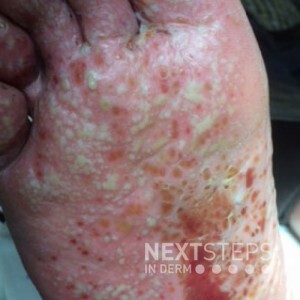
The correct answer is D. Acitretin.
The image displays palmoplantar pustulosis (PPP) which represents chronic sterile pustules over the palms and soles. Many patients who develop PPP have no pre-existing psoriasis. TNF-a inhibitors have been implicated in the development of palmoplantar pustulosis. Acitretin, among other treatments, is a first line option.
This image could also represent Generalized pustular psoriasis (GPP), which is a rare and serious skin disorder that presents with flares of widespread sterile pustules on a background of red and tender skin. However, only palms and soles are seen in the photo. Histologically numerous neutrophils are seen in the epidermis. Acitretin is an effective therapy. It may progress to erythroderma and may cause loss of the nails if it progresses to the distal digits.
IL-36 inhibitors are a possible advance in the treatment of GPP and PPP.
This is not an infectious process or infestation, therefore doxycycline, terbinafine, and ivermectin is not correct.
Adalimumab (and other TNF-a inhibitors) is not a preferred agent, even with the association of palmoplantar pustulosis and psoriasis.
References:
In Bolognia, J., In Schaffer, J. V., & In Cerroni, L. (2018). Dermatology.
Raposo I, Torres T. Palmoplantar Psoriasis and Palmoplantar Pustulosis: Current Treatment and Future Prospects. Am J Clin Dermatol. 2016;17(4):349-358. doi:10.1007/s40257-016-0191-7
Krueger J, Puig L, Thaçi D. Treatment Options and Goals for Patients with Generalized Pustular Psoriasis. Am J Clin Dermatol. 2022;23(Suppl 1):51-64. doi:10.1007/s40257-021-00658-9
